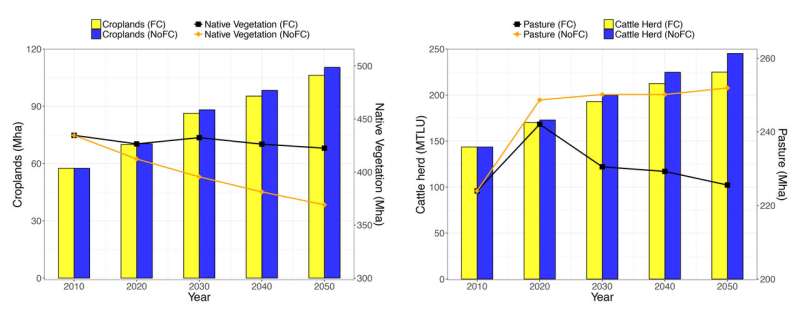Brazil's Forest Code can balance the needs of agriculture and the environment

If fully implemented, Brazil's Forest Code, an environmental law designed to protect the country's native vegetation and regulate land use, will not prevent growth in Brazilian agriculture, according to new IIASA-led research.
The team set out to understand the implications of fully enforcing the Forest Code on both the environment and agriculture to the year 2050. Deforestation is currently increasing in Brazil after a long decrease, largely as a result of increased demands for land for agriculture. Agriculture, both arable and livestock, is a hugely important industry for Brazil. It is the world's largest sugar and beef exporter, the second largest maize exporter and the third largest soybean exporter. While many studies have only looked at deforestation in the Amazon, the new study looks at the whole country, where in some areas, such as the Cerrado, deforestation is happening at an even faster rate. Here, only 20 percent of the native vegetation remains.
Soterroni and the team used the Brazilian regional version of a partial equilibrium model called the Global Biosphere Management Model (GLOBIOM-Brazil), developed at IIASA and INPE, to compare and contrast two future scenarios, one in which the Forest Code is fully implemented and enforced, and one in which it is not. Historically, the Forest Code has been seen as too restrictive to agriculture.
In both scenarios, the agricultural sector in Brazil will continue to grow. If fully enforced, the Forest Code will reduce cropland area in Brazil by only 4 percent, compared to the scenario without the Forest Code. The cattle herd need only be 8 percent smaller under the Forest Code.
One important change is that cattle farming will need to intensify. The researchers estimate that as the total area for pasture decreases, productivity will need to increase by 56 percent over the next four decades, for example with the use of supplements and the adoption of semi-intensive pasture management.
An important point to note is that net native vegetation levels remain virtually unchanged. Enforcing the Forest Code would prevent the loss of 53.4 million ha of native vegetation across Brazil, including 43.1 million ha in the Amazon. Part of this will come from the obligatory restoration of 12.9 million ha of forest under the code.
"Our projections show that the full enforcement of the Forest Code will not prevent the agricultural sector to continue growing in the coming decades, while the lack of enforcement could allow widespread conversion of the native vegetation into agricultural land, especially in the Amazon biome," says Soterroni.
Additionally, Soterroni says that their research has shown that the Forest Code, and the resulting fall in deforestation combined with forest restoration, could make a significant impact in meeting Brazil's internationally agreed climate targets under the Paris Agreement. While in places like the US and Europe most emissions come from the other sectors rather than agriculture, forestry and other land use (AFOLU), in Brazil, around 70 percent of the country's emissions come from AFOLU, mainly from deforestation. Regulating these, then, is Brazil's main focus in climate protection.
As such, the research has already impacted Brazilian policy. Soterroni explains that while the peer-reviewed paper has only just been published, the work has been ongoing for a while and was used in the development of Brazil's Nationally Determined Contribution (NDC) under the Paris Agreement, to reduce emissions by 43 percent by 2030. The NDC now specifies that 12 million ha of deforested areas should be restored and the Forest Code properly enforced.
"The main message here is that the Forest Code, although not perfect, could bring a compromise between agriculture and environment. In Brazil, any land-use policy to be successful must take into account both sectors. Our study shows that if the new Forest Code is properly enforced, production and protection can be reconciled," says Soterroni.
More information: Aline C Soterroni et al, Future environmental and agricultural impacts of Brazil's Forest Code, Environmental Research Letters (2018). DOI: 10.1088/1748-9326/aaccbb
Journal information: Environmental Research Letters





















